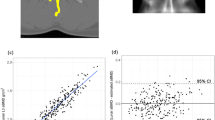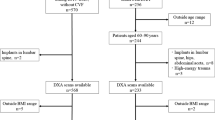Abstract
Summary
A QCT-based nonlinear FEM was used to assess vertebral strength and mechanical parameters in postmenopausal women. It had higher discriminatory power for vertebral fracture than aBMD and vBMD. Alendronate effects were detected at 3 months, and marked bone density increases were noted in juxta-cortical areas compared to inner trabecular areas.
Introduction
QCT-based finite element method (QCT/FEM) can predict vertebral compressive strength ex vivo. This study aimed to assess vertebral fracture risk and alendronate effects on osteoporosis in vivo using QCT/FEM.
Methods
Vertebral strength in 104 postmenopausal women was analyzed, and the discriminatory power for vertebral fracture was assessed cross-sectionally. Alendronate effects were also prospectively assessed in 33 patients with postmenopausal osteoporosis who were treated with alendronate for 1 year.
Results
On the age and body weight adjusted logistic regression, vertebral strength had stronger discriminatory power for vertebral fracture (OR per SD change: 6.71) than areal BMD and volumetric BMD. The optimal point for the vertebral fracture threshold was 1.95 kN with 75.9% sensitivity and 78.7% specificity. At 3 months, vertebral strength significantly increased by 10.2% from baseline. The minimum principal strain distribution showed that the area of high fracture risk decreased. At 1 year, the density of the inner cancellous bone increased by 8.3%, while the density of the juxta-cortical area increased by 13.6%.
Conclusions
QCT/FEM had higher discriminatory power for vertebral fracture than BMD and detected alendronate effects at 3 months. Alendronate altered density distributions, thereby decreasing the area with a high fracture risk, resulting in increased vertebral strength.





Similar content being viewed by others
References
NIH Consensus Development Panel on Osteoporosis Prevention D, and Therapy (2001) Osteoporosis prevention, diagnosis, and therapy. JAMA 285:785–795
Edmondston SJ, Singer KP, Day RE et al (1994) In-vitro relationships between vertebral body density, size and compressive strength in the elderly thoracolumbar spine. Clin Biomech 9:180–186
Cheng XG, Nicholson PH, Boonen S et al (1997) Prediction of vertebral strength in vitro by spinal bone densitometry and calcaneal ultrasound. J Bone Miner Res 12:1721–1728
Eriksson SA, Isberg BO, Lindgren JU (1989) Prediction of vertebral strength by dual photon absorptiometry and quantitative computed tomography. Calcif Tissue Int 44:243–250
Myers BS, Arbogast KB, Lobaugh B et al (1994) Improved assessment of lumbar vertebral body strength using supine lateral dual-energy X-ray absorptiometry. J Bone Miner Res 9:687–693
Bjarnason K, Hassager C, Svendsen OL et al (1996) Anteroposterior and lateral spinal DXA for the assessment of vertebral body strength: comparison with hip and forearm measurement. Osteoporos Int 6:37–42
Marshall D, Johnell O, Wedel H (1996) Meta-analysis of how well measures of bone mineral density predict occurrence of osteoporotic fractures. BMJ 312:1254–1259
Cody DD, Gross GJ, Hou FJ et al (1999) Femoral strength is better predicted by finite element models than QCT and DXA. J Biomech 32:1013–1020
Keyak JH, Rossi SA, Jones KA et al (1998) Prediction of femoral fracture load using automated finite element modeling. J Biomech 31:125–133
Keyak JH, Rossi SA, Jones KA et al (2001) Prediction of fracture location in the proximal femur using finite element models. Med Eng Phys 23:657–664
Keyak JH (2001) Improved prediction of proximal femoral fracture load using nonlinear finite element models. Med Eng Phys 23:165–173
Bessho M, Ohnishi I, Matsuyama J et al (2007) Prediction of strength and strain of the proximal femur by a CT-based finite element method. J Biomech 40:1745–1753
Faulkner KG, Cann CE, Hasegawa BH (1991) Effect of bone distribution on vertebral strength: assessment with patient-specific nonlinear finite element analysis. Radiology 179:669–674
Silva MJ, Keaveny TM, Hayes WC (1998) Computed tomography-based finite element analysis predicts failure loads and fracture patterns for vertebral sections. J Orthop Res 16:300–308
Martin H, Werner J, Andresen R et al (1998) Noninvasive assessment of stiffness and failure load of human vertebrae from CT-data. Biomed Tech 43:82–88
Buckley JM, Loo K, Motherway J (2007) Comparison of quantitative computed tomography-based measures in predicting vertebral strength. Bone 40:767–774
Crawford RP, Cann CE, Keaveny TM (2003) Finite element models predict in vitro vertebral body compressive strength better than quantitative computed tomography. Bone 33:744–750
Liebschner MA, Kopperdahl DL, Rosenberg D et al (2003) Finite element modeling of the human thoracolumbar spine. Spine 28:559–565
Imai K, Ohnishi I, Bessho M et al (2006) Nonlinear finite element model predicts vertebral bone strength and fracture site. Spine 31:1789–1794
Lian KC, Lang TF, Keyak JH et al (2005) Differences in hip quantitative computed tomography (QCT) measurements of bone mineral density and bone strength between glucocorticoid-treated and glucocorticoid-naive postmenopausal women. Osteoporos Int 16:642–650
Keaveny TM, Donley DW, Hoffmann PF et al (2007) Effects of teriparatide and alendronate on vertebral strength as assessed by finite element modeling of QCT scans in women with osteoporosis. J Bone Miner Res 22:149–157
Melton LJ III, Riggs BL, Keaveny TM et al (2007) Structural determinants of vertebral fracture risk. J Bone Miner Res 22:1885–1892
Orimo H, Hayashi Y, Fukunaga M et al (2001) Diagnostic criteria for primary osteoporosis: year 2000 revision. J Bone Miner Metab 19:331–337
Imai K, Ohnishi I, Yamamoto S et al (2008) In vivo assessment of lumbar vertebral strength in elderly women using computed tomography-based nonlinear finite element model. Spine 33:27–32
World Health Organization (1994) Assessment of fracture risk and its application to screening for postmenopausal osteoporosis. Report of a WHO Study Group. World Health Organ Tech Rep Ser 843:1–129
Devogelaer JP, Broll H, Correa-Rotter R et al (1996) Oral alendronate induces progressive increases in bone mass of the spine, hip, and total body over 3 years in postmenopausal women with osteoporosis. Bone 18:141–150
Tucci JR, Tonino RP, Emkey RD et al (1996) Effect of three years of oral alendronate treatment in postmenopausal women with osteoporosis. Am J Med 101:488–501
Black DM, Cummings SR, Karpf DB et al (1996) Randomised trial of effect of alendronate on risk of fracture in women with existing vertebral fractures. Fracture Intervention Trial Research Group. Lancet 348:1535–1541
Liberman UA, Weiss SR, Broll J et al (1995) Effect of oral alendronate on bone mineral density and the incidence of fractures in postmenopausal osteoporosis. The Alendronate Phase III Osteoporosis Treatment Study Group. N Engl J Med 333:1437–1443
Cummings SR, Black DM, Thompson DE et al (1998) Effect of alendronate on risk of fracture in women with low bone density but without vertebral fractures: results from the Fracture Intervention Trial. JAMA 280:2077–2082
Pols HA, Felsenberg D, Hanley DA et al (1999) Multinational, placebo-controlled, randomized trial of the effects of alendronate on bone density and fracture risk in postmenopausal women with low bone mass: results of the FOSIT study. Fosamax International Trial Study Group. Osteoporos Int 9:461–468
Ensrud KE, Black DM, Palermo L et al (1997) Treatment with alendronate prevents fractures in women at highest risk: results from the Fracture Intervention Trial. Arch Intern Med 157:2617–2624
McClung MR, San Martin J, Miller PD et al (2005) Opposite bone remodeling effects of teriparatide and alendronate in increasing bone mass. Arch Intern Med 165:1762–1768
Black DM, Greenspan SL, Ensrud KE et al (2003) The effects of parathyroid hormone and alendronate alone or in combination in postmenopausal osteoporosis. N Engl J Med 349:1207–1215
Dougherty G, Newman D (1999) Measurement of thickness and density of thin structures by computed tomography: a simulation study. Med Phys 26:1341–1348
Prevrhal S, Engelke K, Kalender WA (1999) Accuracy limits for the determination of cortical width and density: the influence of object size and CT imaging parameters. Phys Med Biol 44:751–764
Boivin GY, Chavassieux PM, Santora AC et al (2000) Alendronate increases bone strength by increasing the mean degree of mineralization of bone tissue in osteoporotic women. Bone 27:687–694
Roschger P, Rinnerthaler S, Yates J et al (2001) Alendronate increases degree and uniformity of mineralization in cancellous bone and decreases the porosity in cortical bone of osteoporotic women. Bone 29:185–191
Cummings SR, Karpf DB, Harris F et al (2002) Improvement in spine bone density and reduction in risk of vertebral fractures during treatment with antiresorptive drugs. Am J Med 112:281–289
McNamara LM, Prendergast PJ (2007) Bone remodelling algorithms incorporating both strain and microdamage stimuli. J Biomech 40:1381–1391
Balena R, Toolan BC, Shea M et al (1993) The effects of 2-year treatment with the aminobisphosphonate alendronate on bone metabolism, bone histomorphometry, and bone strength in ovariectomized nonhuman primates. J Clin Invest 92:2577–2586
Fischer KJ, Vikoren TH, Ney S et al (2006) Mechanical evaluation of bone samples following alendronate therapy in healthy male dogs. J Biomed Mater Res B Appl Biomater 76:143–148
Acknowledgments
This work was funded by a grant in aid for Scientific Research received from the Japan Society for the Promotion of Science (14657356).
Conflicts of interest
None.
Author information
Authors and Affiliations
Corresponding author
Rights and permissions
About this article
Cite this article
Imai, K., Ohnishi, I., Matsumoto, T. et al. Assessment of vertebral fracture risk and therapeutic effects of alendronate in postmenopausal women using a quantitative computed tomography-based nonlinear finite element method. Osteoporos Int 20, 801–810 (2009). https://doi.org/10.1007/s00198-008-0750-8
Received:
Accepted:
Published:
Issue Date:
DOI: https://doi.org/10.1007/s00198-008-0750-8




